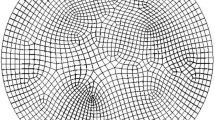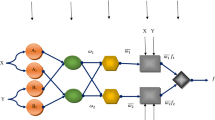Abstract
In the present article, generalization performances of regularization network (RN) and optimize adaptive neuro-fuzzy inference system (ANFIS) are compared with a conventional software for prediction of heat transfer coefficient (HTC) as a function of superficial gas velocity (5–25 cm/s) and solid fraction (0–40 wt%) at different axial and radial locations. The networks were trained by resorting several sets of experimental data collected from a specific system of air/hydrocarbon liquid phase/silica particle in a slurry bubble column reactor (SBCR). A special convection HTC measurement probe was manufactured and positioned in an axial distance of 40 and 130 cm above the sparger at center and near the wall of SBCR. The simulation results show that both in-house RN and optimized ANFIS due to powerful noise filtering capabilities provide superior performances compared to the conventional software of MATLAB ANFIS and ANN toolbox. For the case of 40 and 130 cm axial distance from center of sparger, at constant superficial gas velocity of 25 cm/s, adding 40 wt% silica particles to liquid phase leads to about 66% and 69% increasing in HTC respectively. The HTC in the column center for all the cases studied are about 9–14% larger than those near the wall region.











Similar content being viewed by others
Abbreviations
- e:
-
Unit vector
- G:
-
Green’s matrix
- H:
-
Smoother matrix
- I :
-
Identity matrix
- N:
-
Number of neurons
- \( \underline{w} \) :
-
Synaptic weight vector
- \( \underline{x} \) :
-
Input vector
- \( \underline{y} \) :
-
Real response values
- μ :
-
Membership function
- X:
-
Input variable
- a, b, c:
-
Premise parameters
- p, q, r:
-
Consequent parameters
- O:
-
Membership grade
- w:
-
Firing strengths
- A, B:
-
Linguistic label
- T S :
-
Surface temperature
- T ∞ :
-
Bulk fluid temperature
- h :
-
Heat transfer coefficient
- λ :
-
Regularization parameter
- \( {\underline{w}}_{\lambda } \) :
-
Linear synaptic weight
- σ:
-
Isotropic spread
- ANFIS:
-
Neuro-fuzzy inference system
- HTC:
-
Heat transfer coefficient
- RN:
-
Regularization network
- SBCR:
-
Slurry bubble column reactor
- ANN:
-
Artificial neural network
- RMSE:
-
Root-mean-square error
References
Elbing BR, Still AL, Ghajar AJ (2016) Review of Bubble Column Reactors with Vibration. Ind Eng Chem Res 55(2):385–403
Vandu C, Krishna R (2004) Volumetric mass transfer coefficients in slurry bubble columns operating in the churn-turbulent flow regime. Chem Eng Process Process Intensif 43(8):987–995
Alvarez E, Correa J, Navaza J, Riverol C (2001) Theoretical prediction of the mass transfer coefficients in bubble columns operating in churn-turbulent flow regime. Study in Newtonian and non-Newtonian fluids under different operation conditions. Heat Mass Transf 37:343–350
Pour AN, Housaindokht MR (2013) Study of activity, products selectivity and physico-chemical properties of bifunctional Fe/HZSM-5 Fischer–Tropsch catalyst: Effect of catalyst shaping. J Nat Gas Sci Eng 14:29–33
Pour AN, Housaindokht MR (2014a) Studies on product distribution of nacrostructure iron catalyst in Fischer–Tropsch synthesis: effect of catalyst particle size. Ind Eng Chem Res 20(2):591–596
Pour AN, Housaindokht MR, Irani M, Shahri SMK (2014b) Size-dependent studies of Fischer–Tropsch synthesis on iron based catalyst: New kinetic model. Fuel 116:787–793
Pour AN, Housaindokht MR, Tayyari SF, Zarkesh J, Shahri SMK (2011) Water-gas-shift kinetics over a Fe/Cu/La/Si catalyst in Fischer–Tropsch synthesis. Chem Eng Res Des 89(3):262–269
Jiang B, Hao L, Zhang L, Sun Y, Xiao X (2015) Numerical investigation of flow and heat transfer in a novel configuration multi-tubular fixed bed reactor for propylene to acrolein process. Heat Mass Transf 51(1):67–84
Kantarci N, Borak F, Ulgen KO (2005) Bubble column reactors. Process Biochem 40(7):2263–2283
Basha OM, Sehabiague L, Abdel-Wahab A, Morsi BI (2015) Fischer–Tropsch synthesis in slurry bubble column reactors: experimental investigations and modeling–a review. Int J Chem React Eng 13(3):201–288
Shaikh A, Al-Dahhan MH (2007) A review on flow regime transition in bubble columns. Int J Chem React Eng 5(1):1–68
Gandhi AB, Joshi JB (2010) Estimation of heat transfer coefficient in bubble column reactors using support vector regression. Chem Eng J 160(1):302–310
Haykin S (1999) Neural networks: a comprehensive foundation. Prentice Hall, Englewood Cliffs
Savari M, Moghaddam AH, Amiri A, Shanbedi M, Ayub MNB (2017) Comprehensive heat transfer correlation for water/ethylene glycol-based graphene (nitrogen-doped graphene) nanofluids derived by artificial neural network (ANN) and adaptive neuro-fuzzy inference system (ANFIS). Heat Mass Transf. https://doi.org/10.1007/s00231-017-2047-y
Pourtousi M, Sahu J, Ganesan P, Shamshirband S, Redzwan G (2015) A combination of computational fluid dynamics (CFD) and adaptive neuro-fuzzy system (ANFIS) for prediction of the bubble column hydrodynamics. Powder Technol 274:466–481
Shaikh A, Al-Dahhan M (2003) Development of an artificial neural network correlation for prediction of overall gas holdup in bubble column reactors. Chem Eng Process Process Intensif 42(8):599–610
Tsutsumi A, Chen W, Hasegawa T, Otawara K (2001) Neural networks for prediction of the dynamic heat-transfer rate in bubble columns. Ind Eng Chem Res 40(23):5358–5361
Al-Masry W (2006) Analysis of hydrodynamics of external loop circulating bubble columns with open channel gas separators using neural networks. Chem Eng Res Des 84(6):483–486
Lin H, Chen W, Tsutsumi A (2003) Long-term prediction of nonlinear hydrodynamics in bubble columns by using artificial neural networks. Chem Eng Process Process Intensif 42(8):611–620
Amiri S, Mehrnia MR, Barzegari D, Yazdani A (2011) An artificial neural network for prediction of gas holdup in bubble columns with oily solutions. Neural Comput & Applic 20(4):487–494
Al-Hemiri AA, Ahmedzeki NS (2008) Prediction of the heat transfer coefficient in a bubble column using an artificial neural network. Int J Chem React Eng 6(1). https://doi.org/10.2202/1542-6580.1655
Golub GH, Van Loan CF (1996) Matrix computations. Johns Hopkins University, Press, Baltimore, pp 374–426
Dikmen E, Ayaz M, Ezen HH, Küçüksille EU, Şahin AŞ (2014) Estimation and optimization of thermal performance of evacuated tube solar collector system. Heat Mass Transf 5(50):711–719
Shahsavand A, Chenar MP (2007) Neural networks modeling of hollow fiber membrane processes. J Membr Sci 297(1):59–73
ZareNezhad B, Aminian A (2012) Accurate prediction of sour gas hydrate equilibrium dissociation conditions by using an adaptive neuro fuzzy inference system. Energy Convers Manag 57:143–147
Salehi H, Zeinali-Heris S, Esfandyari M, Koolivand M (2013) Nero-fuzzy modeling of the convection heat transfer coefficient for the nanofluid. Heat Mass Transf 4(49):575–583
Karami A, Yousefi T, Ebrahimi S, Rezaei E, Mahmoudinezhad S (2013) Adaptive neuro-fuzzy inference system (ANFIS) to predict the forced convection heat transfer from a v-shaped plate. Heat Mass Transf 6(49):789–798
Esfandyari M, Fanaei MA, Gheshlaghi R, Mahdavi MA (2016) Neural network and neuro-fuzzy modeling to investigate the power density and Columbic efficiency of microbial fuel cell. J Taiwan Inst Chem Eng 58:84–91
Pourtousi M, Ganesan P, Sandaran SC, Sahu J (2016) Effect of ring sparger diameters on hydrodynamics in bubble column: A numerical investigation. J Taiwan Inst Chem Eng 69:14–24
Girosi F, Jones M, Poggio T (1995) Regularization theory and neural networks architectures. Neural Comput 7(2):219–269
Asil AG, Shahsavand A (2014) Reliable estimation of optimal sulfinol concentration in gas treatment unit via novel stabilized MLP and regularization network. J Nat Gas Sci Eng 21:791–804
Poggio T, Girosi F (1990) Networks for approximation and learning. Proc IEEE 78(9):1481–1497
Shahsavand A, Ahmadpour A (2005) Application of optimal RBF neural networks for optimization and characterization of porous materials. Comput Chem Eng 29(10):2134–2143
Tow EW (2014) Heat transfer to a horizontal cylinder in a shallow bubble column. Int J Heat Mass Transf 79:353–361
Deckwer W-D, Field RW (1992) Bubble column reactors, vol 200. Wiley New York
Krishna R, Sie S (2000) Design and scale-up of the Fischer–Tropsch bubble column slurry reactor. Fuel Process Technol 64(1):73–105
Acknowledgements
The authors wish to acknowledge the financial support granted by Ferdowsi University of Mashhad.
Author information
Authors and Affiliations
Corresponding author
Ethics declarations
Conflict of interest
On behalf of all authors, the corresponding author states that there is no conflict of interest.
Additional information
Publisher’s Note
Springer Nature remains neutral with regard to jurisdictional claims in published maps and institutional affiliations.
Rights and permissions
About this article
Cite this article
Garmroodi Asil, A., Nakhaei Pour, A. & Mirzaei, S. Reliable prediction of heat transfer coefficient in three-phase bubble column reactor via adaptive neuro-fuzzy inference system and regularization network. Heat Mass Transfer 54, 2975–2986 (2018). https://doi.org/10.1007/s00231-018-2332-4
Received:
Accepted:
Published:
Issue Date:
DOI: https://doi.org/10.1007/s00231-018-2332-4




